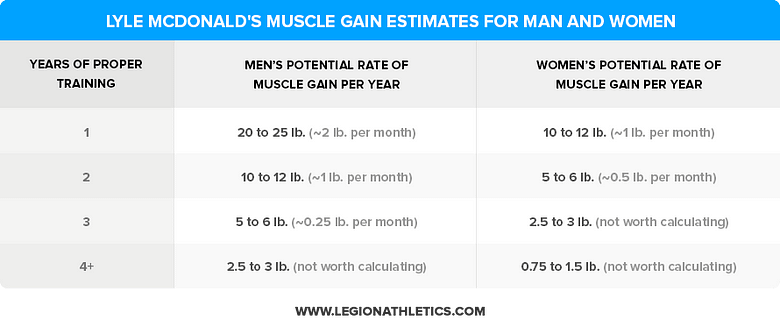
I’ve been working out on and off for more than 20 years. I’ve always enjoyed the challenge, the endorphin boosts, and the physical effects on the body you can slowly appreciate over time.
It’s an exercise in willpower, consistency, and in some ways, life.
How long can you keep at a hobby that’s proven to make your body younger, your brain happier, and your bones fit for life?
The reason I said on and off before is I sometimes fall victim to a lack of consistency. Life gets in the way, of course, but so do our own bad habits.
Fortunately, one of the best ways I’ve found to combat this and keep heading back into the dumbbell jungle is by maximizing my time there.
In this case — I want to talk about gaining muscle — one of the main purposes of hitting those weights. The last decade has seen the release of a lot of meta-studies resolutely stating some basic concepts that were previously debatable.
And since you’re all busy working out so often, why not use this knowledge and apply it to your own lifting sessions?
How much muscle can you gain in a month?
There are a few basics to knowing how much muscle you can gain over time. Namely, are you brand new to weightlifting or have recently come back to the sport after a long break? Are you experienced? Are you male or female?
Answering these questions lets us use one of the most widely accepted models for estimating muscle gains for weight lifters — Lyle McDonald’s model:

If you’re a bit surprised at how much the estimated muscle gains are for the first year in that chart, it’s simply due to newbie gains — a real thing.
Most other models you’ll find out there won’t be too far off from this, but personally, I find this to be the most accurate — given optimal conditions.
Bottom line:
Muscle gains vastly depend on how experienced a trainer you are, but for the first two years, you can expect to gain 1–2 lbs per month (males) in optimal conditions (or 0.5 to 1 lbs for women).
How many times per week should you lift weights?
A conclusive meta-study performed in 2016 showed significantly greater benefits for working out each muscle group at least twice per week, rather than just once.
Note, it did not measure if there were further benefits beyond twice per week.
However, Greg Nuckols spent a huge amount of time collecting studies that showed even greater effects for lifters that go more than twice a week (all the way up to 6 x).
The studies he looked at all revolved around muscle hypertrophy (gaining physical size in your muscles).
Bottom line:
Try to hit each muscle group 2–3 times per week if you can, for maximum gains in strength and size.
How long does it take for muscles to fully recover?
Related to the above question, knowing how long muscles take to recover is extremely important to avoid overtraining.
Unfortunately, due to the massive differences in individuals’ physiques and what kind of workouts they do, it’s hard to find general studies that show just how long it takes muscles to recover.
The general rule of thumb is to wait 36 to 48 hours after training a muscle group before hitting it again. If you’re new to weight lifting, the first few weeks will often take a bit longer.
Basically, if your muscle feels sore (called DOMS — delayed onset muscle soreness), don’t work it out again until it feels better.
There are also scientifically-backed ways to reduce the amount of time to recover. People usually call this active recovery these days.
The best ways to practice active recovery are to perform light exercises in the days following your workout. Stuff like walking, jogging, yoga, and swimming for example.
If you’re keen, muscle massages and cold-water immersion have also been shown to slightly reduce recovery time.
It almost goes without saying that getting enough sleep, protein, and essential nutrients will drastically help your recovery periods too.
Bottom line:
Wait at least 36 to 48 hours before retraining the same muscle group. If you have time, try to perform light exercise during that time window as well.
How many reps and sets should you do each week?
Another controversial area in weightlifting is the optimal level of reps (repetitions of each weight lifting exercise) and sets (how many reps you complete in a row) you should do.
There’s an insane amount of studies on this area which makes it difficult if not impossible to state a specific number.
It also depends on what each athlete is training for. Stamina? Volume? Strength? These all tend to complicate the ideal conditions.
Nevertheless, I find this huge examination of multiple recent studies and papers to be quite complete, and I follow their conclusions.
Bottom line:
- Hit each muscle group (ex. chest) between 9 to 18 sets each week
- Each set should be 6 to 20 proper performed reps
- These sets should come within 1–2 reps of complete failure (ex. 2 reps before you can’t lift the weight anymore)
- If you’re new, start even lower than this until you gradually get more comfortable with the workload
How much protein do I need to eat to gain muscle?
One of the most up-to-date and extensive reviews of this controversial subject is pretty clear on the results for how much protein weightlifters should eat every day.
The study states:
“Beyond a daily intake of 1.6 g/kg body mass per day (up to as high as 2.2 g/kg/day), the additional effects of protein are greatly diminished.”
It goes on to recommend that if you’re actively lifting weights, you should be aiming for a minimum of 1.6 grams per kg of body weight, and don’t bother eating more than 2.2 grams.
(For my American friends — 0.72 grams per pound, up to 1.0 grams per pound of body mass)
Personally, I aim for a minimum of 1.6 g/kg every day. Eating that much protein can take a lot of effort, and a lot of scoops of protein. Going overboard and eating hundreds of grams of protein every day is a myth of the past. Save your time and your money.
Bottom line:
Aim for 1.6 g/kg of body mass per day, all the way up to 2.2 g/kg if you want to. Anything beyond that is practically useless for natural athletes.
What else can I do to increase muscle growth?
One of the most important aspects of building muscle is getting adequate rest. And this definitely includes getting at least 7–9 hours of sleep on recovery nights (if not all the time).
Beyond that, eating enough protein is essential as well. Proper fats, vitamins, and fiber go a long way too.
If you’re an experienced weight lifter and you want to up your game to the next level naturally-ish, there are two supplements out there that are readily (and legally) available.
I personally use creatine and protein powder as my main supplements. I also take magnesium pills daily as it’s been shown a huge percentage of us are deficient in this mineral in the West.
Creatine is a naturally occurring substance most often found in meats. It helps your muscles by increasing phosphocreatine stores in your body, which can boost your workouts.
It’s also been shown to have a lot of other intriguing benefits when supplemented properly — like boosting brainpower.
Protein powder comes in two main forms. A slow-digesting casein protein(the less common version), and a fast-digesting whey protein. They’re both derived from milk and are a cost-effective way to add that much-needed protein to your diet when building muscle.
Bottom line:
- Get 7 to 9 hours of sleep, especially on recovery days
- Eat enough protein and make sure the rest of your diet is good too
- Consider protein powder and/or creatine if you’re looking to build muscle faster
Takeaway
I hope this guide was able to help shed some light on the often controversial topic of gaining muscle. There are countless studies out there and for each one, there are 10,000 articles, guides, and courses created on the subject.
Fortunately for us, science keeps on rolling and they’ve been able to come to more concrete (although not quite complete) theories on how our bodies function — especially with weight lifting.
Every minute we spend in the gym is precious to us, so if you’re anything like me, you want to maximize the results from all of that time invested.
So good luck, good lifting, and good day to all of you readers!
J.J. Pryor
If you enjoyed this article, you might also like my free weekly newsletter. Thanks for reading!
If you want to make the gym less boring, you might want to learn about what is Audible Plus?



